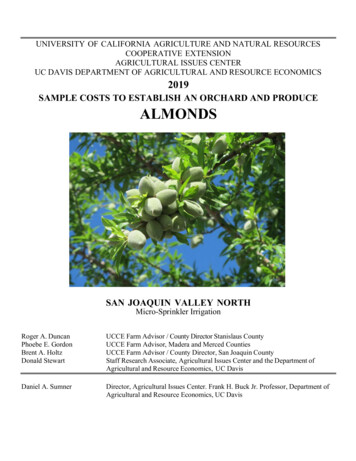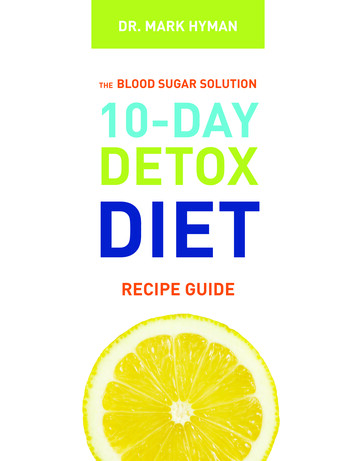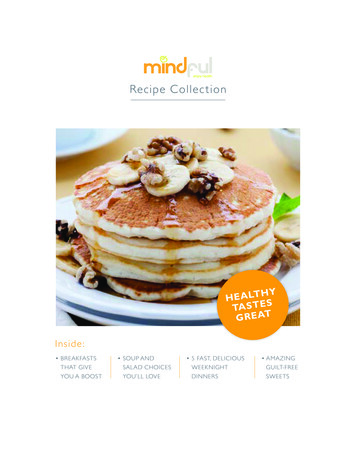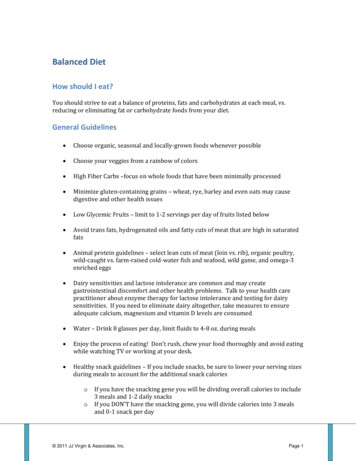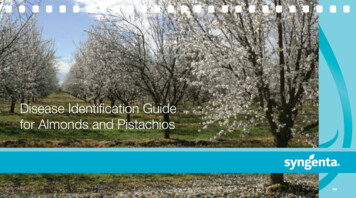
Transcription
Disease Identification Guidefor Almonds and Pistachios
Table of ContentsIntroduction . 1Seasonal Calendar . 3Almonds . 4Pistachios . 6Treatments . 7Bravo Weather Stik Fungicide . 8Inspire Super Fungicide . 10Quadris Top Fungicide . 14Ridomil Gold SL Fungicide . 18Vangard WG Fungicide . 20Disease Identification for Almonds . 23Alternaria Leaf Spot . 24Anthracnose . 26Brown Rot Blossom Blight . 28Green Fruit Rot (Jacket Rot) . 30Leaf Blight . 32Leaf Rust . 34Phytophthora Crown, Collar and Root Rot . 36Rhizopus Hull Rot . 38Scab . 40Shot Hole . 42Disease Identification for Pistachios .Alternaria Late Blight .Botryosphaeria Panicle and Shoot Blight .Botrytis Blossom and Shoot Blight .Septoria Leaf and Fruit Blight .4546485052Resources . 55Almonds & Pistachios
Almonds & PistachiosCommitment to the Almond and Pistachio IndustriesWe are focused on a healthy tree: Help provide whole-season protectionfor tree health with a comprehensiveportfolio of leading fungicides, insecticides,and herbicides to deliver maximum yieldsand qualityWe are your valued partner: Invest and support the almond andpistachio industries Help growers protect their investmentIntroduction1
Introduction2Syngenta’s Commitment toHelping Growers ManageDisease ResistanceSyngenta provides products with a wide rangeof chemistries and different modes of action, soalmond and pistachio growers have a diverse arsenalto combat a broad range of diseases. Syngenta’sdeep portfolio combined with in-field expertise givesgrowers both the tools and the knowledge to managehard-to-control diseases. With trusted brands andongoing research investment, Syngenta is committedto protecting the tools we have and developing newdisease management tools for the future.Almonds & Pistachios
Seasonal CalendarSeasonal Calendar
Seasonal Calendar4Seasonal Calendarfor AlmondsDISEASESDormantPink BudFull BloomPetal FallTwo WeeksPost Petal FallFive WeeksPost Petal FallSpring SpraysHull SplitHarvest**Alternarialeaf spotAnthracnoseBrown rotblossom blightGreen fruit rot(jacket rot)***Leaf blight** Quadris Top and Abound are not recommended for strobilurin-resistant alternaria*** Suppression onlyAlmonds
AlmondsSeasonal Calendarfor AlmondscontinuedDISEASESDormantPink BudFull BloomPetal FallTwo WeeksPost Petal FallFive WeeksPost Petal FallSpring SpraysHull SplitHarvestLeaf RustPhytopthoracrown, collarand root rotScab dormant oil*Shot holeRhizopushull rot*** Syngenta supports a recommendation of FIFRA Section 2(ee) application of Bravo Weather Stik for tank-mixure with agricultural oil on almonds at the recommended rates in California.** Syngenta supports a recommendation of FIFRA Section 2(ee) application of Quadris Top for the control of rhizopus hull rot in almonds.Seasonal Calendar5
Seasonal Calendar6Seasonal Calendarfor ernarialate blightBotryosphaeriapanicle andshoot blightBotrytisblossom andshoot blightSeptoria leafand fruit blightPistachios
TreatmentsTreatments
Bravo Weather Stik8For Proven Wet WeatherPerformance ChooseBravo Weather StikBravo Weather Stik fungicide, with its patented SuperWeather Stik formulation, adheres tightly to the leaf surfacefor persistent coverage you can count on, even in heavy rains.During dormancy use Bravo Weather Stik to protect against scab,or use it later in the season to manage Alternaria leaf spot andanthracnose. Whatever the target, the broad-spectrum activity,residual control and tank-mix flexibility make Bravo Weather Stikthe obvious choice for almond growers.Almonds
AlmondsBravo Weather Stik Recommendations for Almonds*Target DiseasesUse RateRemarksBlossom blight/brown rot(Monilinia spp.)4 pt/A(3 lb a.i./A)Anthracnose(Colletotrichum acutatum)1.33 pt/100 gal**(1 lb a.i./100 gal**)Application:Use water volumes of 20-300 gal/A. For blossom blight, begin applications at popcorn (pink bud) andfollow with an application at full bloom. If weather is still conducive for disease development, anotherapplication may be made at petal fall.Scab(Venturia carpophila)Shot hole(Wilsonomyces carpophilus)For control of shot hole, make an application in the autumn at leaf fall. In the spring, make the firstapplication at bud break, followed by an application at shuck split to control nut infections and scab.For dormant application from December 1 through December 31. Apply Bravo Weather Stik at the rateof 4 pt/A (64 fl oz/100 gal/A - concentrate application) in a tank mixture with 4 gal agricultural oil peracre. For dilute applications, use 1.33 pt product and 1 gal oil/100 gal (maximum of 300 gal/A).For control of anthracnose on almonds, apply 4 pt/A (3 lb a.i./A) or 1.33 pt/100 gal application mix(1 lb a.i./A). Use a water volume of 20-300 gal/A.Apply by ground or air.Specific Use Restrictions: Do not apply within 150 days of harvest. Do not apply more than 25 pt/A of Bravo Weather Stik (18.75 lb a.i.) during each growing season(leaf fall through shuck split).*Please consult the Bravo Weather Stik label for complete use instructions.**Volumetric rates to be used only with full dilute spray specified on the Bravo Weather Stik label for treeand orchard crops.Bravo Weather Stik9
Inspire Super10Get Top of the ClassAlmond Disease Controlwith Inspire Super FungicideInspire Super fungicide offers disease control that issecond to none for almonds and pistachios. It utilizes theunique active ingredient difenoconazole with translaminaractivity and Vangard WG fungicide with systemic activityto deliver long-lasting control of damaging diseases. Fortop-notch almonds and pistachios, growers can trustInspire Super.Almonds & Pistachios
AlmondsInspire Super Recommendations for Almonds*Target DiseasesUse RateRemarksBlossom blight(Monilinia spp.)16-20 fl ozof product/AFor blossom blight, apply 16-20 fl oz/A during the bloom period. The minimum retreatment interval is14 days. Make no more than two sequential applications before alternating to another fungicide with adifferent mode of action. If disease pressure is high, use the highest rate.Alternaria leaf spot(A. alternata)Green fruit rot(Botrytis cinerea)Scab(Cladosporium carpophilum)Anthracnose(Colletotrichum acutatum)Leaf blight(Seimatosporium lichenicola)Leaf rust(Tranzschelia discolor)Shot hole(Wilsonomyces carpophilus)For Alternaria leaf spot and scab, begin applications prior to disease onset when conditions areconducive for disease. If monitoring or history indicates the presence of Alternaria, apply 20 fl oz/A ofInspire Super in the late spring (mid-April to beginning of May) and then repeat the treatment two to threeweeks later. Make no more than two sequential applications before alternating to another fungicide witha different mode of action. The minimum retreatment interval is 14 days. If disease pressure is high, usethe shortest interval and the highest rate.For all other diseases, use 16-20 fl oz/A. Begin applications prior to disease onset when conditions areconducive for disease. Apply Inspire Super on a 14-21 day schedule making no more than two sequentialapplications before alternating to another fungicide with a different mode of action. The minimumretreatment interval is 14 days. If disease pressure is high, use the shortest interval and highest rate.Application: For best results, sufficient water volume must be used to provide thorough coverage.Use a minimum of 50 gal/A for ground applications. Use a minimum of 10 gal/A of water for aerialapplications. Use ground application for best results.Specific Use Restrictions: Make no more than two applications by air. 60-day PHI*Please consult the Inspire Super label for complete use instructions.Inspire Super11
Inspire Super12Inspire Super Recommendations for Pistachios*Target DiseasesUse RateRemarksAlternaria late blight(Alternaria spp.)16-20 fl ozof product/ABegin applications prior to disease onset when conditions are conducive for disease. Apply Inspire Superon a 14-21 day schedule making no more than two sequential applications before alternating to anotherfungicide with a different mode of action. If disease pressure is high, use the shortest interval and thehighest rate.Botrytis(Botrytis spp.)Panicle and shoot blight(Botryosphaeria dothidea)Application:Application may be made by ground or air. For best results, sufficient water volume must be used toprovide thorough coverage. Use a minimum of 50 gal/A for ground applications. Use a minimum of 10gal/A of water for aerial application. Use ground application for best results.Specific Use Restrictions: Do not apply within 14 days of harvest.*Please consult the Inspire Super label for complete use instructions.Pistachios
Quadris Top14Optimized to DeliverPeak Performance Across aBroad Spectrum of Almondand Pistachio DiseasesQuadris Top fungicide exhibits preventive, systemicand curative activity, and offers foliar disease controlwhenever it’s needed. It protects almonds and pistachiosfrom a broad spectrum of profit-robbing diseases. It helpsprotect almonds from Alternaria leaf spot, anthracnose,blossom blight, leaf blight, leaf rust, scab and shot hole.On pistachios, it helps combat Alternaria late blight,panicle and shoot blight, and Septoria leaf spot.Almonds & Pistachios
AlmondsQuadris Top Recommendations for Almonds*Target DiseasesUse RateRemarksAlternaria leaf spot(A. alternata)12-14 fl ozof product/AFor blossom blight, begin applications at early bloom and continue through petal fall. Make no more thantwo sequential applications before alternating to another fungicide with a different mode of action.Anthracnose(Colletotrichum acutatum)Blossom blight(Monilinia spp.)Leaf blight(Seimatosporium lichenicola)For all other diseases, begin applications prior to disease onset when conditions are conducive fordisease. Apply Quadris on a 14-21 day schedule making no more than two sequential applicationsbefore alternating to another fungicide with a non-Qol (Group 11) mode of action.If monitoring or history indicates the presence of Alternaria, apply 14 fl oz/A of Quadris Top in the latespring (mid-April to beginning of May) and then repeat treatment two to three weeks later.If disease pressure is high, use the shortest interval and highest rate.Leaf rust(Tranzschelia discolor)Scab(Venturia carpophila)Shot hole(Wilsonomyces carpophilus)Quadris Top15
Quadris Top16Quadris Top Recommendations for Almonds* continuedTarget DiseasesUse RateRemarksRhizopus hull rot(Rhizopus stolonifer)14 fl oz of product /Aat 1% hull split andrepeat no later than40% hull split ifconditions remainfavorable fordevelopment ofdisease (hull dryinglikely to extendbeyond 4 weeks)Apply Quadris Top by ground at 1% Hull Split in a minimum of 100 gal/A. Thorough coverage of thealmond hull is essential for disease control.Applications can be made with standard Navel Orangeworm applications.If hull drying is likely to extend beyond 4 weeks then a subsequent application of Quadris Top may beapplied before 40% hull split but not inside of the 28 day pre harvest interval.Application:By ground or by air but for best disease control, ground applications are strongly recommended. Goodcoverage is essential for effective disease control. For ground applications a minimum of 100 gal/A.Apply as a foliar spray in sufficient water to obtain thorough coverage of foliage.Specific Use Restrictions: Do not apply more than 14 fl oz/A per spray Do not apply more than 2 consecutive Quadris Top sprays Do not exceed 56 fl oz/A of Quadris Top per acre per year. 28-day PHI 12 hour REI*Please consult the Quadris Top label for complete use instructions.Almonds
PistachiosQuadris Top Recommendations for Pistachios*Target DiseasesUse RateRemarksAlternaria late blight(Alternaria spp.)12-14 fl ozof product/ABegin applications prior to disease onset when conditions are conducive for disease. Apply Quadris Topon a 14-21 day schedule making no more than two sequential applications before alternating to anotherfungicide with a non-QoI (Group 11) mode of action. If disease pressure is high, use the shortest interval.Panicle and shoot blight(Botryosphaeria dothidea)Septoria leaf spot(S. pistaciarum)Application:For best results, sufficient water must be used to provide thorough coverage. Quadris Top can beapplied by either ground or aerial application. A minimum of 15 gal/A for ground applications isrecommended. For aerial applications, a minimum of 10 gal/A of water is recommended.Specific Use Restrictions: Do not use with an adjuvant Do not apply more than 56 fl oz/A of Quadris Top per crop Do not apply more than 0.46 lb a.i./A per crop of difenoconazole-containing products Do not apply more than 1.5 lb a.i./A per crop of azoxystrobin-containing products 14-day PHI*Please consult the Quadris Top label for complete use instructions.17
Ridomil Gold SL18Providing Effective RootProtection in a ProvenFormulationRidomil Gold SL fungicide offers long-lasting diseaseprotection against several species of Phytophthora thatcan infect the roots and crown of the tree, and it effectivelycontrols crown, collar rot and root rot caused byPhytophthora species. The hyperactive systemic activityof Ridomil Gold SL protects the plant from the inside outand results in higher yields and quality at harvest. Fromplanting to year-to-year tree maintenance, Ridomil Gold SLhelps keep roots healthier and trees more productive.Almonds & Pistachios
AlmondsRidomil Gold SL Recommendations for Almonds*Target DiseasesUse RateRemarksCrown rot2 qt/A(2 lb a.i./A)Application:Soil spray (broadcast or band): Apply under the tree canopy to cover the root zone two weeks afterplanting (new plantings) or in the spring before growth begins (established plantings). Additionalapplication may be made at two- to three-month intervals, depending on the disease pressure. Make upto three applications per year. Apply before symptoms appear. Ridomil Gold SL will not revitalize treesshowing moderate to severe symptoms. For intense plantings (two to three times the normal plantingrate), apply on a per area basis (1,000 sq ft).Collar rotRoot rot(Phytophthora spp.)or1.5 fl oz/1,000 sq ftSpecific Use Restrictions: Do not exceed the equivalent of 6 lb a.i./A per crop of soil-applied mefenoxam-containing products. In California, do not apply to newly planted trees within 45 days of planting. On some varieties,chlorosis may occur on leaf margins.*Please consult the Ridomil Gold SL label for complete use instructions.Ridomil Gold SL19
Vangard WG20Outstanding Early-SeasonDisease Control for Almondand Pistachio OrchardsVangard WG offers almond and pistachio growers thevery best in early-disease protection. Active against a widerange of fungal diseases, Vangard WG helps fight brown rot,jacket rot, and shot hole in almonds and Botrytis and Alternariain pistachios. The powerful activity of Vangard also protects thedelicate flowers from Monilinia infection, and the residual activityon the tree suppresses other diseases.Almonds & Pistachios
AlmondsVangard WG Recommendations for Almonds*Target DiseasesUse RateRemarksBrown rot blossom blight(Monilinia spp.)5-10 ozof product/AApplication:Apply Vangard WG at 5-10 percent bloom. Additional applications at 50-100 percent bloom and petal fallmay be necessary.Suppression Only:Green fruit rot (jacket rot)(Botrytis cinerea)Shot hole(Wilsonomyces carpophilus)When used for control of brown rot blossom blight, Vangard WG will provide suppression of shot hole.For suppression of green fruit rot, apply at full bloom.For broad-spectrum disease control in tank mixture, apply Vangard WG at a minimum rate of 5 oz in tankmixtures with other fungicides registered for use on almonds.Disease suppression for almond diseases refers to erratic control from fair to good, or consistent controlat a level below that obtained with products registered for control.Specific Use Restrictions: Do not apply more than 30 oz/A of Vangard WG per plot of land per year Make no more than two applications by air 60-day PHI*Please consult the Vangard WG label for complete use instructions.Vangard WG21
Vangard WG22Vangard WG Recommendations for Pistachios*Target DiseasesUse RateRemarksBotrytis(Botrytis spp.)5.5-7 ozof product/AMake the first application during early bloom and repeat applications at 14-day intervals if conditionsremain favorable for disease development.Alternaria(Alternaria alternate)Application:Application may be by ground. Good coverage is essential for good disease control. Use a minimum of20 gal/A spray volume by air.Specific Use Restrictions: Make no more than two applications by air. Do not apply more than 28 oz/A of Vangard WG (1.3 lb a.i./A of cyprodinil) per plot of land per year. 7-day PHI*Please consult the Vangard WG label for complete use instructions.Pistachios
Disease IdentificationAlmondsAlmond Diseases
24Alternaria Leaf SpotAlternaria Leaf Spot – Alternaria alternataSymptomsInfections appear as brown, circular lesions thatcoalesce into large, irregular necrotic zones on leaves.Courtesy: Malcolm MediaLesions often become black in the center wherenumerous spores are produced.Almonds
AlmondsDisease CycleSymptoms of these leaf lesions are typicallyfound in late summer. However, outbreaks canoccur earlier and become severe enough to causedebilitating defoliation (especially in the southernSan Joaquin Valley).Conditions for DevelopmentWarm temperatures, dew and humidity are idealconditions for Alternaria leaf spot development. Thisdisease is consistently worse in areas of little or no airmovement and where dew remains for many hourseach day in late spring through summer.Alternaria Leaf Spot25
26AnthracnoseAnthracnose – Colletotrichum acutatumSymptomsLeaf infections areyellow, irregular lesionsthat begin at the leafmargin or tip andadvance toward themiddle of the leaf.Infected nuts showround, orange colored,sunken lesions on thehull. Profuse gummingoccurs as the infectionprogresses intothe kernel.Courtesy: J. AdaskavegCourtesy: J. AdaskavegAlmonds
AlmondsSymptoms of anthracnose on almonds includeblossom blight and fruit infections, often with spurand limb dieback. Infected flowers look similar tobrown rot strikes.The shoots orbranches that bearinfected nuts often die.Disease CycleThe anthracnose fungus overwinters in dead woodor in mummified fruit that remains attached to thetree. Orange lesions on the infected nuts may appearas early as three weeks after petal fall or later in theseason if conditions are favorable. The shoots orbranches that bear infected nuts often die. Althoughthe fungus may invade fruit wood, it is seldomcultured from affected branches. Death of the woodmay result from a toxin rather than from colonizationof the wood by the fungus.Conditions for DevelopmentAll cultivars appear to be susceptible to anthracnose.Warm, rainy weather is ideal for anthracnosedevelopment. Pruning out infected woods helpsreduce inoculum and limits the spread of disease.Courtesy: J. AdaskavegAnthracnose27
28Brown Rot Blossom BlightBrown Rot Blossom Blight – Monilinia laxa, M. fructicolaSymptomsSpore massescolored gray to tancollect on diseasedflower parts.Young blossomspurs and nearbyleaves collapse to formshoot blight.Courtesy: Malcolm MediaInfected twigs exhibitcankers with tan centersand dark margins. Thesecankers often exude gummymaterials (gummosis).Courtesy: Malcolm MediaAlmonds
AlmondsDisease CycleThe brown rot blossom blight fungus overwintersin twig cankers and on residual flower parts andspurs. Spore pads grow on these structures in latewinter for primary inoculum in the spring. The sporesare airborne or rain-splashed. Therefore, stigma,anthers and petals are all susceptible to infection,especially when the flower is open.Conditions for DevelopmentBlossom blight infections are most commonat bloom until petal fall. Optimum conditions fordevelopment include foggy or rainy weather withtemperatures around 75 F, but infection can developwith temperatures as low as 50 F to 60 F.Brown Rot Blossom Blight29
30Green Fruit Rot (Jacket Rot)Green Fruit Rot (Jacket Rot) –Botrytis cinerea, Sclerotinia sclerotiorum, Monilinia laxaSymptomsGreen fruit rot begins during the latter part of thebloom period when the fungus infects senescingpetals and anthers. Infected petals developwater-soaked brown spots. Some infected petals mayfall onto leaves causing secondary infections. Antherinfections can spread to floral tubes or flower jacketscausing them to wither and stick to developing fruit.Courtesy: B. T. Teviotdale. Reproducedfrom Compendium of Nut Crop Diseasesin Temperate Zones, 2002, AmericanPhytopathological Society, St. Paul, Minn.Almonds
AlmondsDisease CycleAs fruit sets and starts to grow, a brown spotdevelops where the jackets stick to it. This isparticularly a problem where nut clusters trapsenescing flower parts. Frequently this leads torot of entire nut clusters.Conditions for DevelopmentWhen conditions are cool and wet during bloom,it can cause severe losses. One or more of severalpathogens may be involved.Green Fruit Rot (Jacket Rot)31
32Leaf BlightLeaf Blight – Seimatosporium lichenicolaSymptomsIn spring and throughout summer, infected leaveswither (at the base of shoots), turn brown and die.Courtesy: B. T. Teviotdale. Reproducedfrom Compendium of Nut Crop Diseasesin Temperate Zones, 2002, AmericanPhytopathological Society, St. Paul, Minn.Almonds
AlmondsDisease CycleThe fungus overwinters on dead petioles thatremain attached to the tree. Spores are spreadby rain. Leaf blight is usually not very severe orwidespread – it rarely destroys more than 20 percentof the leaves in one season. But repeated suddendeath of leaves will weaken trees and may contributeto yield loss.Conditions for DevelopmentThe leaf blight fungus favors wet spring weather.Leaf Blight33
34Leaf RustLeaf Rust – Tranzschelia discolorSymptomsInitial symptoms ofthis disease are yellowspots on the upperleaf surfaces.Reddish to darkbrown colored rustlesions appear on thelower leaf surfaces.Courtesy: Malcolm MediaCourtesy: Malcolm MediaAlmonds
AlmondsDisease CycleThe leaf rust fungus overwinters on twigs or leaves,surviving in twig lesions or on other host parts. Rustis usually a late-season problem that can causerapid defoliation.Conditions for DevelopmentThe spread of infection occurs in moist conditions.Unless there are mid-season rains, leaf rust occursonly sporadically in the Sacramento Valley and is veryuncommon in California cultivars.Leaf Rust35
36Phytophthora Crown, Collar and Root RotPhytophthora Crown, Collar and Root Rot –Phytophthora spp.SymptomsSymptom expression depends upon how much ofthe root or crown tissues are affected and how quicklythey are destroyed. Generally, crown rots advancerapidly and trees collapse and die soon after the firstwarm weather of spring. Leaves of such trees wilt, dryand remain attached to the tree. Chronic infections,usually of the roots, cause reduction in growth andearly senescence and leaf fall. These trees may beunthrifty for several years before succumbing to thedisease. Phytophthora infections typically kill youngtrees because their root systems and crown areas aresmall compared to those of mature trees.Courtesy: B. L. Teviotdale. Reproducedfrom Compendium of Nut Crop Diseasesin Temperate Zones, 2002, AmericanPhytopathological Society, St. Paul, Minn.Almonds
AlmondsDisease CycleProper water management is the most importantaspect in controlling root and crown rot. Do notallow water to accumulate or stand around crownsof trees. Provide adequate drainage to low spots inthe orchards, areas that flood frequently and placeswhere water penetration is extremely poor or leaveareas unplanted.Rootstocks vary in susceptibility to the differentPhytophthora species; none are resistant to allpathogenic species of the fungus. Thus, the successof a rootstock may depend in part upon the speciesof Phytophthora present in the orchard. In general,plum rootstocks are more resistant than are peachor peach-almond hybrids. Of the plum rootstocks,Marianna 2624 is the most tolerant toPhytophthora species.Conditions for DevelopmentPeriods of 24 hours or more of saturated soilfavor Phytophthora infections. Conversely, good soildrainage and more frequent but shorter irrigationsreduce the risk of root and crown rot. Surface waterfrom irrigation districts is mostly contaminated withPhytophthora species.Phytophthora Crown, Collar and Root Rot37
38Rhizopus Hull RotRhizopus Hull Rot – Rhizopus stoloniferSymptomsBlack fungal growthon the inside of the hull.Source: SyngentaAlmonds
AlmondsDisease CycleFungi produce atoxin that kills the shootattached to the fruit.This causes other greenfruit to not mature andtherefore remain on thetree after harvest.Productivity is reducedin future years due todieback and fruitingwood.Conditions for DevelopmentRhizopus hull rot threatens almonds from thebeginning of hullsplit until the hulls dry. Dependingon fertilization and irrigation, this period that canlast from 10 days to 2 months.Source: SyngentaRhizopus Hull Rot39
40ScabScab – Cladosporium carpophilumSymptomsSpots are soft-lookingand grayish-blacklesions. They canappear on leaves,nuts and twigs.To check for younglesions, hold a leaf upto the light and look forindistinct yellow specks.Defined lesions areusually not visible untillate spring or earlysummer.Courtesy: Malcolm MediaCourtesy: Malcolm MediaAlmonds
AlmondsDisease CycleThe scab fungus overwinters in twig lesions.Starting in March, spores are spread by wind, rainand sprinkler irrigation. The disease often occurs inorchards where the irrigation is sufficient to reach thefoliage at the bottom of the tree.Severe early-seasonepidemics incitepremature leaf dropthat may result in earlynut drop.Conditions for DevelopmentScab favors prolonged, wet spring weather.Courtesy: J. AdaskavegScab41
42Shot HoleShot Hole – Wilsonomyces carpophilusSymptomsLeaf lesions start as reddish specks that grow intospots with tan centers and purplish margins. A smalldark dot (the sporulating structure) appears inside thespot. Spots on young leaves usually fall out, leaving ashot hole effect.Courtesy: B. L. Teviotdale. Reproducedfrom Compendium of Nut Crop Diseasesin Temperate Zones, 2002, AmericanPhytopathological Society, St. Paul, Minn.Almonds
AlmondsConditions for DevelopmentShot hole is most severe during prolonged wetspring weather. Mild temperatures and free moistureare necessary for spores to be produced, germinateand infect plant tissue. Prolonged periods of wetnessdue to either rain or sprinkler irrigation can enhancethe spread and intensity of the disease, particularly inthe lower branches.Disease CycleOn fruit, lesions aresmall and raised, withpurple borders. Theyusually appear on thetop of the fruit as ithangs on the tree.Severe infection maydistort the fruit orcause gumming.Courtesy: B. L. Teviotdale. Reproducedfrom Compendium of Nut Crop Diseasesin Temperate Zones, 2002, AmericanPhytopathological Society, St. Paul, Minn.Shot Hole43
Disease IdentificationPistachiosPistachio Diseases
46Alternaria Late BlightAlternaria Late Blight – Alternaria alternataSymptomsSmall leaf lesions form with characteristic chloroticmargins. On immature (green) nuts, lesions are blackand small (about 1 mm in diameter). Lesions onmature nuts are black, vary in size and are surroundedby reddish margins.Courtesy: T. J. Michailides. Reproducedfrom Compendium of Nut Crop Diseasesin Temperate Zones, 2002, AmericanPhytopathological Society, St. Paul, Minn.Pistachios
PistachiosDisease CycleAlternaria commonly occurs in nature and caneasily develop on crop debris and senescing leaves ofweeds. Spores are spread by air currents or splashedby water drops. “Late blight” describes Alternariain pistachios because it develops – in its mostsevere form – late in the season during maturationof pistachio nuts. Early fruit symptoms show in lateJune, with the disease becoming very severe fromlate August to September on mature pistachios.Conditions for DevelopmentThis pathogen favors high relative humidity anddew formation. It is a particular problem in orchardsirrigated by sprinklers or flooding, although it can bea problem in orchards irrigated with micro-sprinklers,particularly in lower areas where relative humidity canbe high and dew formation is frequent.Alternaria Late Blight47
48Botryosphaeria Panicle and Shoot BlightBotryosphaeria Panicle and Shoot Blight –Botryosphaeria dothideaSymptomsIn mid-spring, youngfruit clusters of shootsblight because ofinfected buds fromthe previous buds fromthe previous growingseason. Advancingcankers also appear.Infected shootsquickly turn black andtheir leaves wilt and dry.Courtesy: T. J. MichailidesCourtesy: T. J. MichailidesPistachios
PistachiosInfected fruit covered with pycnidia (blackstructures) of the fungus (August to September).increase to epidemic proportions within
Almond Disease Control with Inspire Super Fungicide e SuperInspir fungicide offers disease control that is second to none for almonds and pistachios. It utilizes the unique active ingredient difenoconazole with translaminar activity and Vangard WG fungicide with systemic activity to deliver long-lasting control of damaging diseases. For

